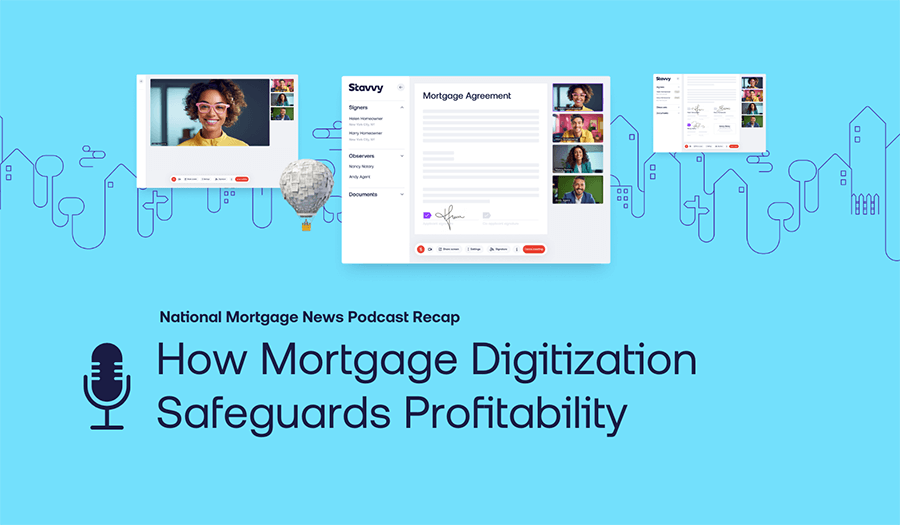As a forward-thinking mortgage lender, you know that digital transformation and digital mortgage technology are the industry's future. And with so many lenders moving toward hybrid and full eClosing, it’s more important than ever to understand the role of an eNote and the benefits that an eNote provides to loan originators and the mortgage industry at large.
Throughout this blog post, you’ll learn more about eNote and its benefits, how eNote works in mortgages, what makes an eNote compliant, and why loan originators are adopting eNote.
What is a mortgage eNote?
An electronic note, or eNote, is a promissory note created, accessed, signed, transferred, and stored electronically. Like a paper promissory note, a mortgage eNote is a binding agreement between the borrower and lender and includes the terms of repayment for a loan, such as the interest rate, loan term, and final loan amount.
However, unlike a paper promissory note, an eNote can never be lost or damaged. Due to the digital nature of the note, physical transfers and endorsements of paper are no longer necessary. Instead, those tasks are replaced with secure electronic processes that make it easier for everyone involved in the loan's lifecycle.
What are eVault and MERS® eRegistry?
Once duly signed, eNotes are sent to an electronic vault, or eVault, for safekeeping and are registered in an electronic registry or eRegistry. The MERS® eRegistry is a secured database that identifies who has the right to enforce the terms of an eNote. This is critical for eNotes because, unlike paper notes, where you can distinguish the original wet signed note from its copies, digital copies of eNotes are practically indistinguishable. The MERS® eRegistry identifies which Org ID, or entity, is the Controller of the Authoritative Copy of an eNote, and which Org ID's eVault holds the Authoritative Copy as the Location, which may be the same as the Controller or an entity acting as the Controller's custodian.
The eVault enables lenders, servicers, investors, and other secured parties to access, view, and transfer ownership of the mortgage eNote without printing or shipping paper. An eVault provides storage for the Authoritative Copy and allows stakeholders to interact with the eRegistry to transfer control and the location of an original eNote if needed.
How to incorporate eNote into the loan origination process
The transition to eNote is quite simple on the lender and consumer side. Lenders can replace paper promissory notes and wet signatures with eNote as soon as they’re ready to capitalize on a more straightforward loan origination process.
From a consumer perspective, the change to eNote is equally as seamless. Instead of asking consumers to sign a physical paper note, the signer can sign the eNote at the closing electronically with the remainder of their closing package using a digital platform, like Stavvy. It’s important to note that a compliant eNote can be signed electronically during in-person or digital closing with the right digital mortgage technology partner, providing lenders and consumers with flexibility and choice.
For the sake of simplicity, we’ll walk you through the process for adopting eNotes using the Stavvy platform.
- Step 1: Generate the eNote in Stavvy.
- Step 2: Once generated, the eNote can be previewed or redrawn for edits.
- Step 3: For both digital and in-person closings, send the eNote as part of a closing package through Stavvy to the mortgage closer, title and settlement agent, or real estate attorney ahead of the closing.
- Step 4: The homeowner can electronically sign the eNote on the Stavvy platform before closing with in-person electronic notarization (IPEN) or remote online notarization (RON).
- Step 5: Stavvy tamper seals and securely stores the eNote in the lender’s eVault, allowing the lender to register the note in the MERS® eRegistry immediately.
What criteria must an eNote comply with?
eNote must be executed on a MISMOⓇ -compliant SmartDocⓇ and comply with various laws, rules, and industry standards to ensure liquidity in the secondary market, including the requirements set forth by:
- Uniform Electronic Transactions Act (UETA)
- Electronic Signatures in Global and National Commerce (ESIGN) Act
- Uniform Commercial Code (UCC)
- Fannie Mae
- Freddie Mac
- Federal Home Loan Bank System
- Ginnie Mae
- MERS® eRegistry
What is a MISMO®-compliant SmartDoc®?
A MISMO SmartDoc is an electronic file that locks together the view of a document (what the consumer sees), the underlying data, including the borrower and loan attributes, the digital signature, and audit information, so that the integrity of the eNote and its data can be system-read, validated, and guaranteed.
Top 4 lender benefits of eNote
With clarity on how an eNote is used in mortgage eClosings, you may be curious to learn why lenders are adopting electronic promissory notes. eNote offers various benefits to loan originators, including improved operational efficiency of closing and post-closing workflows and transferring a mortgage to the secondary market. Some of the top lender benefits of eNote include:
1. eNote can reduce the cost per loan
Lenders can save on the cost per mortgage transaction by increasing productivity and eliminating the need to mail and store a paper mortgage note.
2. eNote can improve lender quality control
Utilizing eNote minimizes costly and time-consuming manual post-closing quality verifications that traditionally rely on ‘stare and compare’ manual processes.
3. eNote can expedite delivery to the secondary market
An eNote can be delivered to government-sponsored enterprises (GSEs) for automatic certification with a click. Similarly, an eNote is electronically delivered to document custodians for review and initial certification for Ginnie Mae mortgage-backed securities (MBS) quickly. With no need to mail a paper mortgage promissory note, eNote instantly increases the velocity of loans.
4. eNote can enhance lender security
eNote eliminates the risk of losing or damaging paper promissory notes. After signing, the tamper-evident seal affixed to an eNote proves that the document has not been changed, protecting the digital promissory note against the threat of alteration.
How to get started with eNote
Stavvy makes it easy to start with eClosing and eNote. Stavvy’s eClosing solution allows lenders to generate and share a compliant eNote instantly with their mortgage closer, title and settlement agent, or real estate attorney for the homeowner’s signature in the platform.
If you’re interested in elevating your eClosing and reducing the cost per loan, improving quality control, and enhancing security, while instantly delivering compliant eNotes to the secondary market, Stavvy has you covered.
Learn more about how the  is taking real estate beyond documents.
is taking real estate beyond documents.



![[Webinar Recap] Advancing Your Digital Default Servicing Strategy](https://blog.stavvy.com/hubfs/advancing-your-digital-default-servicing-strategy-blog-recap.png)